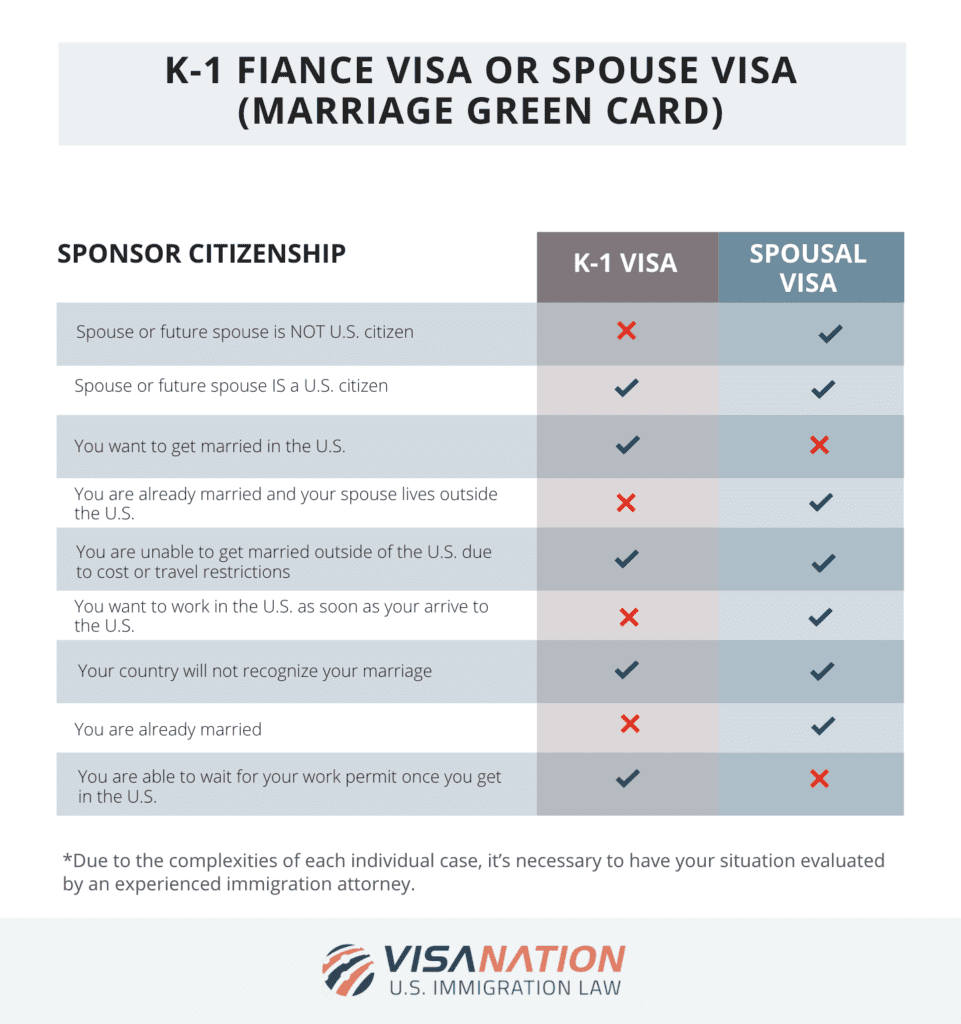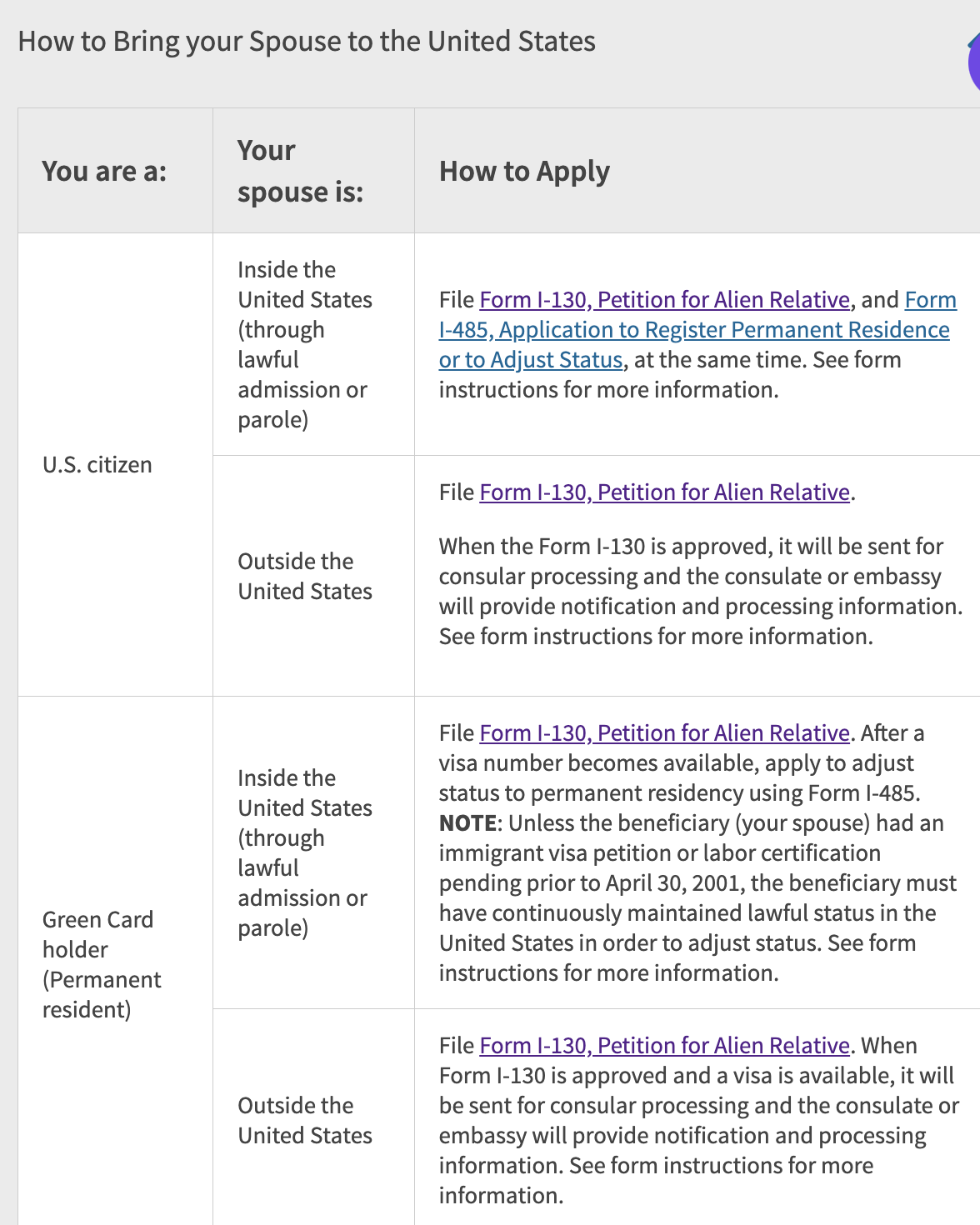Deciding between a fiancé visa vs spouse visa can be confusing. The two visas have their distinct requirements, benefits and advantages disadvantages that should be taken into account before starting the process. This guide breaks down the differences to help you make an informed decision and start your green card application with confidence.
Getting a Green Card for Your Loved Ones is Quick and Easy with VisaNation
Fiancé Visa vs Spouse Visa: Key Differences Explained
The key difference between a fiancé(e) visa and a marriage visa is that the fiancé visa permits you to get married within the U.S., while the marriage visa is more applicable if you were already married outside of the country.
With the fiancé(e) visa, you must get married within 90 days; otherwise, the foreign partner will need to leave the U.S.
Due to the fast nature of organizing all the wedding plans within that time frame, it can feel rushed.
Civil Marriage Versus Religious Ceremony
There’s also a difference between a civil marriage and a religious ceremony. Due to time constraints, sometimes couples on a fiancé(e) visa prefer to have a civil marriage due to the speed and efficiency.
There’s nothing stopping someone from having a religious ceremony outside of the U.S. that isn’t legally recognized as a marriage under U.S. law. However, if you’re considering this, it’s best to speak with an immigration attorney to understand how it may affect your immigration options.

What Is a Fiancé (K-1) Visa?
- Allows U.S. citizens to bring their fiancé(e) to the U.S. to marry within 90 days.
- Requires filing Form I-129F, which takes about 6 months to process.
- After marriage, apply for adjustment of status to become a legal permanent resident (Takes 9.5 months processing according to USCIS data)
-
Faster overall than spouse visas (K-3 or CR-1/IR-1 visa), but with a strict 90-day marriage deadline.
What Are Spouse Visas: CR-1, IR-1, and K-3
A “spouse” is defined as the legally wedded husband or wife, including same-sex spouses of U.S. citizens and LPRs. In some cases, common-law spouses may qualify for the same benefits. A spouse visa includes two main options: the IR-1/CR-1 immigrant visas and the K-3 nonimmigrant visa.
IR-1 and CR-1
The IR-1 is for spouses married for more than two years, granting permanent residency immediately. The CR-1 is for those married for less than two years and provides conditional permanent residency. Both visas require filing Form I-130, followed by either adjustment of status (if the spouse is already in the U.S.) or consular processing (if applying from abroad).
- The whole process takes 9.5 months if done from within the U.S.
- The whole process takes 20.6 months if done from outside the U.S.
K-3
The K-3 visa shortens the separation time while your I-130 petition is processed, as the I-130 can take over a year to process. The K-3 visa allows the spouse to enter the U.S. as a nonimmigrant while waiting for the immigrant visa to be finalized.
It requires filing Form I-130 and a subsequent Form I-129F, which takes 5.7 months to process, according to USCIS data.
Depending on your situation, it might be better to apply for one of these options.
Start your immigration journey with VisaNation and let us take care of your application.
Which One Is For You? Fiancé Visa or Spouse Visa
With both visas, you must demonstrate proof that you have a bona fide relationship. With a fiancé(e) visa, you must get married in the United States, whereas with a K-3 spouse visa or CR-1/IR-1 marriage visas, you must have been married outside the country.
Several deciding factors come into play when choosing the right immigration option for you:
K-1 fiancé(e) visa is better if:
- You want a wedding in the U.S..
- You cannot marry abroad due to laws or traditions.
- You want faster processing overall.
Marriage visa CR-1/IR-1 is better if:
- You are on a budget. Marriage visas are relatively cheaper than the K-1 visa.
- You want your spouse to become a lawful permanent resident when they arrive in the U.S..
- You are determined to have a wedding ceremony in the U.S.; or
- You don’t mind waiting a little bit longer compared to a K-1 visa.
K-3 spouse visa is for you if:
- You want your spouse in the U.S. while waiting for the immigrant visa.
Get a Green Card for Your Partner with VisaNation
Differences in Requirements: Fiancé vs Spouse Visa
It is crucial to compare eligibility requirements between the fiancé(e) visa and marriage visas. The eligibility criteria differ drastically between the two, which may play a big role in to which option applies to your situation.
If you or your partner is considering applying for a fiancé visa, these are the requirements to fulfill:
- The partner initiating the visa application must hold American citizenship at the time of application. Otherwise, if the initiating partner only holds a green card as a permanent resident, bringing the other partner into the country would necessitate applying for a spouse visa.
- The initiating partner must provide evidence demonstrating the legitimacy of the relationship. This evidence may include a marriage certificate and other supporting documentation.
- Both you and your partner must be eligible to marry legally, meaning both parties must be officially divorced from any previous spouses.
- Additionally, both parties must demonstrate that they have met in person at least once within the two years preceding the filing of the visa application.
If you or your partner is considering applying for a spouse visa, these are the steps:

You should not be in any other marriage at the time of your immigration application. If you were previously married, you will need to provide evidence proving that that marriage has ended, either bythe death of the spouse, divorce, or annulment.
Learn more about Form I-864 and Form I-864A.
Which is Faster–Fiance or Spouse Visa
- K-1 fiancé visa often processes faster overall because it skips the I-130 petition processing time, which takes over a year.
- Spouse visas usually take longer because of the I-130 petition and immigrant visa process.
- The K-3 visa may help reduce separation, but it does not always speed up the overall timeline for a green card
Spouses Of Permanent Residents
In some cases, the spouse of a permanent resident will be on a waitlist until the visa or green card becomes available, but this waiting period is shorter than in other family immigration categories.
Bring Your Loved Ones to the U.S.
Filing Fee Differences: Fiancé vs Spouse Visa
Fiancé Visa Costs
- Form I-129F: $675
- U.S. State Department processing DS-160: $265
- Medical Exam: Varies
- Adjustment of Status: $1,440
- Additional fees apply if the immigrant would like a travel permit or a work permit
Total government fees: $2380
Spousal Visa Costs
- For the immigrant visa, there’s a filing fee of $625 (online filing) or $675 (paper filing) for Form I-130
- $325 to the consulate for the DS-260 application
- $120 for the affidavit of support
- USCIS Immigrant Fee: $220 (paid after visa approval, before arriving in the U.S.)
- Any denials or rejections can lead to higher costs and additional wait time to bring your loved one to the U.S.
Total government fees: $1,290
Income Requirement Differences – Marriage Visas
Regardless of whether you opt for a fiancé(e) or spouse visa, your income (petitioners) income level will be taken into consideration. If you first get married and then petition for your spouse to enter the U.S., you need to demonstrate that your income isn’t below 125% of the poverty level. Afterwards, when your spouse is applying for a green card through an adjustment of status, you’ll have to meet the higher 125% requirement.









